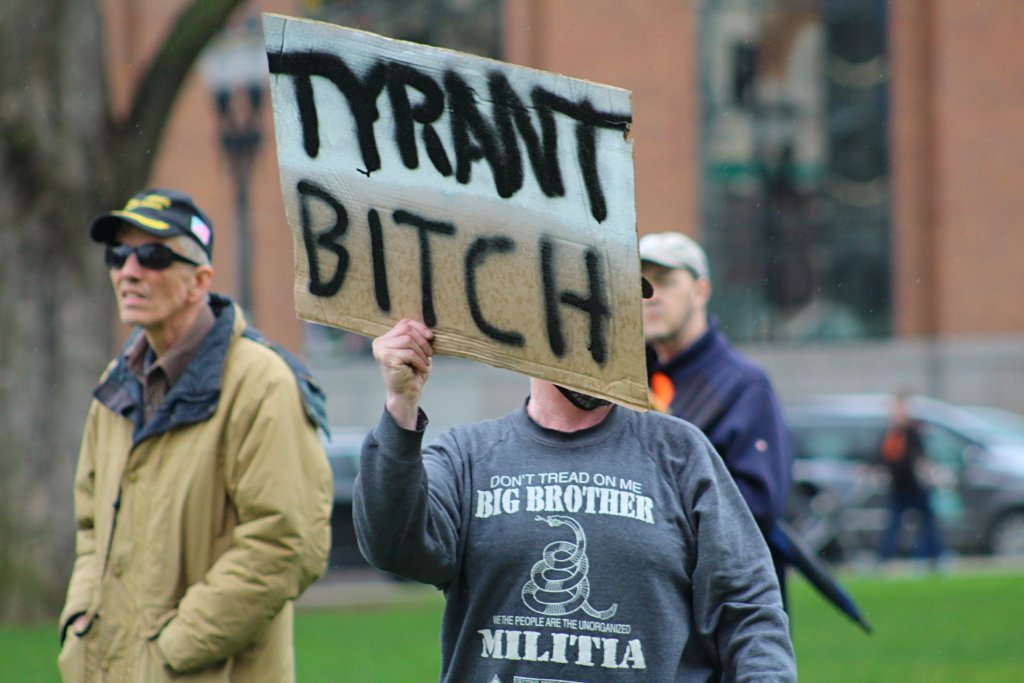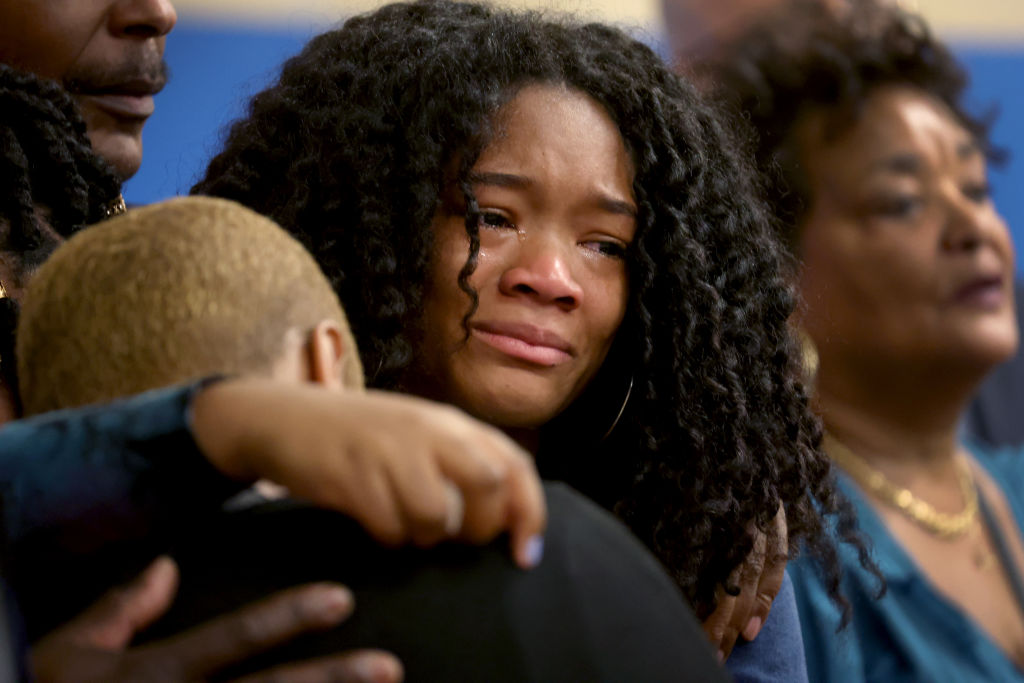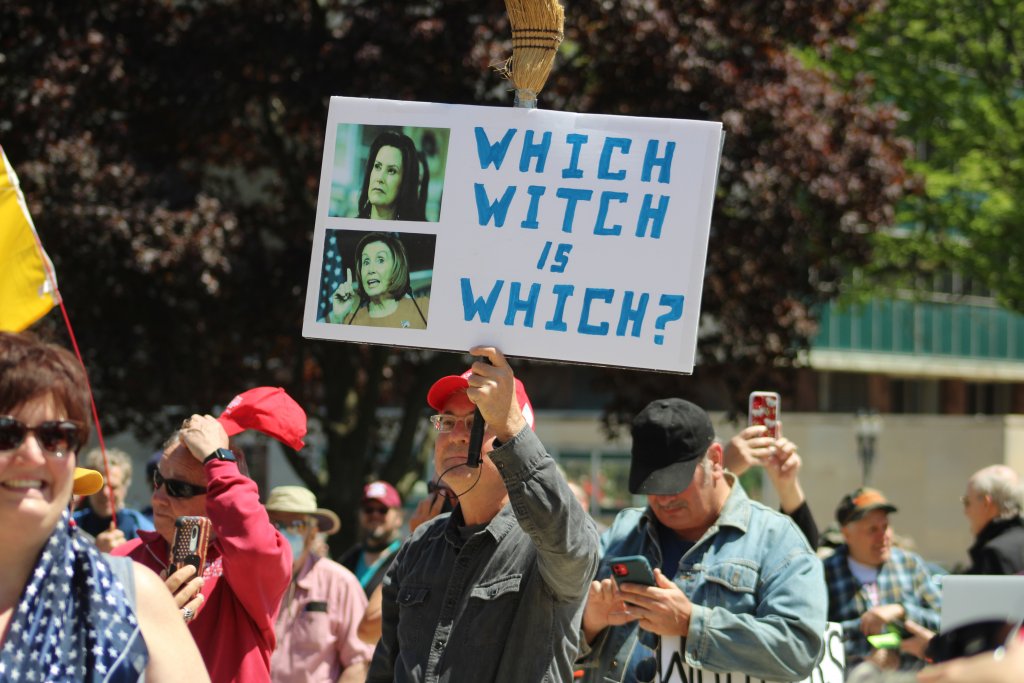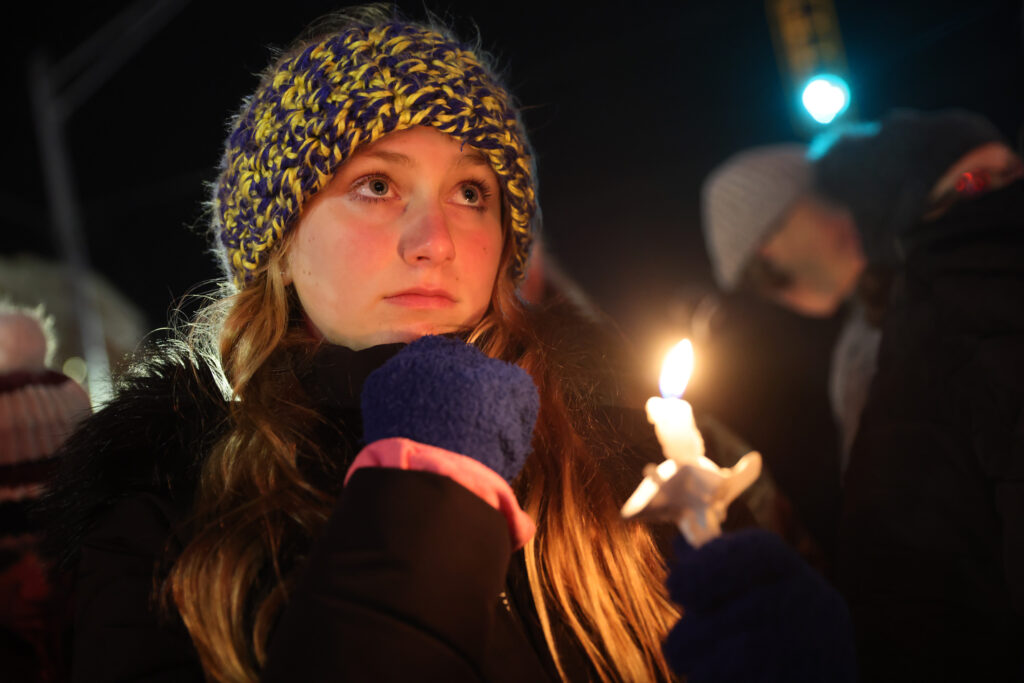OXFORD, MICHIGAN – DECEMBER 03: People attend a vigil to honor those killed and wounded during a shooting at Oxford High School on December 03, 2021 in Oxford, Michigan. Four students were killed and seven others injured on November 30, when student Ethan Crumbley allegedly opened fire with a pistol at the school. Crumbley has been charged in the shooting. His parents were also charged. Photo by Scott Olson/Getty Images.
Dawn Gillard’s life revolved around her children.
Everyone who loved her knew that. The rest of the world would read about it in her obituary.
On May 27, Gillard was shot and killed at age 40 alongside her three young children: Katelynn, 6; Ronald, 4; and Joshua, 3, at a home in Austin Township, a rural area south of Big Rapids in Mecosta County, Michigan. Gillard’s husband, 51-year-old Charles Gillard, has been charged in their murders.
“Becoming a mom was a pinnacle of Dawn’s life,” her obituary read. “Her children quickly became the focus of her drive and making their world a place of joy.”
Gillard, an only child who left behind three older children and her own parents, was, the obituary said, “an active mom” who loved taking her children “out in nature for their long walks.”
Now, “She and her three youngest children will forever be tied together in life and death.”
The deaths of Gillard and her three children are one of 12 mass shootings in Michigan and one of more than 330 mass shootings nationwide that have occurred this year, according to the Gun Violence Archive. The Washington D.C.-based nonprofit defines a mass shooting as four or more people being shot or killed in a single incident, not including the shooter.
These are violent deaths that leave behind often unhealable wounds for those who loved them — people who describe a searing pain that never fully recedes.
And they are the deaths behind the soaring gun violence in the United States, a country where the number of mass shootings has skyrocketed from 272 incidents in 2014 to 692 in 2021, according to the Gun Violence Archive, which began collecting information about mass shootings in 2013.
In a country where there are more firearms than people, mass shootings have become increasingly frequent — and gun violence in general is on the rise. More Americans died from gun violence in 2020, the most recent year for which there is data, than any other year on record, and gun violence was the No. 1 cause of death for children in 2020.
In the past year, the country has grappled with an onslaught of mass shootings, from a 15-year-old boy shooting and killing four students and wounding seven others at Oxford High School in Southeast Michigan; a gunman killing seven people and wounding dozens more during a July 4 celebration in Highland Park, Ill.; another gunman killing 19 children and two teachers in Uvalde, Texas — the deadliest mass shooting in 2022; and a gunman and avowed white supremacist shooting and killing 10 people at a supermarket in Buffalo, N.Y.
This violence has so thoroughly permeated our day-to-day lives that people have stopped going to some public spaces because they’re worried about mass shootings. When the American Psychological Association surveyed about 2,000 people regarding their stress levels following mass shootings in El Paso, Texas, and Dayton, Ohio, in 2019, one-third of respondents said they would no longer go to certain public spaces or events out of a fear of violence.
Amidst this terror, experts are grappling with why this is happening. The answer to that is layered: There’s the fact that guns are ubiquitous in the United States (in a country of about 330 million people, gun owners possess about 393.3 million weapons, and gun ownership soared during the pandemic). AR-15s — often the weapon of choice for mass shooters — are readily available and used to quickly kill large numbers of people in a short amount of time.
Other factors are state gun laws vary dramatically, and primarily Republican lawmakers have for decades resisted gun restrictions meant to curb violence. Following the Uvalde and Buffalo shootings — after years of obstructing movement on gun legislation — some Republican legislators recently joined their Democratic colleagues and passed the most comprehensive federal gun safety legislation, the Safer Communities Act, in nearly 30 years.
But there’s a large piece missing to many of the conversations around gun violence, some academics, lawmakers and other experts said. We are not sufficiently talking about the role that misogyny — and, often, its collision with white supremacy — plays in gun violence.

Right-wing protest at the Capitol against Gov. Gretchen Whitmer before attendees stormed the building while the Legislature was meeting, April 30, 2020. Photo by Anna Liz Nichols/Michigan Advance.
That omission comes as there’s a litany of examples of misogyny in gun violence, including the fact that more than two-thirds (68.2%) of mass shootings in the U.S. involve shooters who either killed family or intimate partners prior to the mass shooting or had another history of domestic violence, according to a 2021 study by the Educational Fund to Stop Gun Violence.
In Michigan, one of every five homicides of women, such as Dawn Gillard, involves a current or former intimate partner with a gun, according to FBI data.
The 18-year-old gunman who killed 19 children and two teachers in Uvalde shot his grandmother in the face before murdering 10- and 11-year-olds who were spending their final days in school before summer vacation. The 20-year-old man who in 2012 shot and killed 26 people at Sandy Hook Elementary School in Connecticut murdered his mother moments before going to the school. The gunman who murdered 49 people at a gay nightclub in Orlando in 2016 abused his wife while she was pregnant, the woman told authorities. The man who killed 26 people at a church in Sutherland Springs, Texas, in 2017 had been convicted of domestic violence; his ex-wife said he told her that, “I could just bury you somewhere here in the desert and nobody would ever find you.”
Mass shooters are also overwhelmingly men — a staggering 98% of mass shootings since 1966 have been committed by men, according to The Violence Project, a research group that tracks U.S. mass shooting data.
“Every day, as virulent white supremacists make their hatred known, we immediately and rightly call them extremists,” a 2018 report from the Anti-Defamation League (ADL) said. “We have not been nearly as unequivocal in our condemnation when it comes to men who express violent anger toward and loathing for women.”
The author of that report, Jessica Reaves, who has for years studied extremist ideologies and groups and is the director of content and editorial strategy at the Anti-Defamation League’s Center on Extremism, said it’s vital for the country to center the role misogyny plays in extremism and violence.
As for why misogyny does not play a larger part of our dialogue and action around extremism and violence, Reaves said, “It’s part of our country.”
“Women were not viewed as full people by the Founding Fathers,” she said. “We didn’t get the right to vote until relatively recently; there’s still no Equal Rights Amendment. There’s no real social cost to being sexist; that was made exceptionally clear in the 2016 presidential election [between Donald Trump and Hillary Clinton, the first major-party female nominee]. There’s no cost to treating women like objects and talking about them as if they’re subhuman.
“We’ve seen racism go unchecked; we’ve seen people hold onto their positions after being antisemitic or Islamophobic,” Reaves continued. “Misogyny falls into that same space where you can dismiss it out of hand because it’s so baked into our country’s fabric, the way we treat mothers and parents, the way we provide no support for child care, the way we don’t pay teachers enough. All of these things are rooted in the belief that women and their contributions are not worth as much. I think that plays into why people can just get away with quite literally murder when it comes to attitudes towards women.”
‘A masculinity epidemic in the United States’
The current gun violence crisis comes at a time when gun ownership soared during the pandemic and the number of white nationalist groups jumped by 55% during the Trump presidency.
There are a lot of guns and a lot of anger — much of which is fueled by misogyny and white supremacy that spreads like a wildfire because of social media — in the country right now, experts said.
“There’s a masculinity epidemic in the United States, and we’re seeing that time and again in these shootings,” said Sarah Prior, a sociology professor at Michigan State University whose research focuses on gendered violence.
Prior and Reaves were careful to note the dangerous collision of misogyny and white supremacy — and how misogyny can often introduce people to white supremacy — and their role in violence.
Misogyny “stands on its own as an extremist ideology” that’s “often interwoven with tenets of white supremacy, antisemitism; there’s all sorts of gross belief systems that depend heavily on hatred of women or play off of hatred of women,” Reaves noted.
The shooter in Buffalo, for example, embraced the virulently racist and antisemitic “Great Replacement” theory, a conspiracy theory advanced by white supremacists, right-wing figures like Fox’s Tucker Carlson, and some Republican lawmakers that centers around white people being systematically replaced by nonwhite people.

BUFFALO, NEW YORK – MAY 16: Family members of 86-year-old Ruth Whitfield who was killed during a mass shooting at Tops market listen as attorney Benjamin Crump speaks during a press conference on May 16, 2022 in Buffalo, New York. A gunman opened fire at the store on Saturday killing ten people and wounding another three. The attack was believed to be motivated by racial hatred. Photo by Scott Olson/Getty Images.
“The most extreme version of the Great Replacement, which is played out in this [the Buffalo shooting] and other white supremacist attacks embraces violent accelerationism — the belief that society as it stands is irredeemable and that only violence can bring about the ideal white state,” Reaves said in an ADL video that aired following the mass shooting in Buffalo.
The Buffalo shooter’s manifesto that allegedly laid out his plans for an attack that ultimately killed 10 Black people at a grocery store was filled with racism and misogyny, according to authorities.
“I carried out the attack” in order to intimidate and remove the “replacers” and to incite violence in order to create an “atmosphere of fear and change” that could “eventually start the war that will save the western world,” the shooter wrote.
“The time for meekness has long since passed,” as has chances for a democratic solution, he continued. “Men of the West must be men once more.”
It’s this misogynist and racist language that experts say points to a theme among mass shooters — including the man who murdered 51 Muslim worshipers at two New Zealand mosques in 2019 and a Norwegian mass murderer who blamed feminism and “soft white men” for the “increasing Islamization of Europe.”
“There’s this overarching sense of grievance you see across the white supremacist board, across the manosphere,” Reaves said, referring to various right-wing online forums that promote misogyny. “There’s a sense of grievance, a sense of victimhood, a sense that something that belongs to them is being taken away.”
In turn, this grievance makes people want to find a scapegoat — and much of the ire among the far right is focused on women, Reaves said. Among a trove of deeply disturbing misogynistic rants that can be found online is a quote that Reaves used in her Anti-Defamation League report on misogyny and white supremacy.
“The fact is, when you give women rights, they destroy absolutely everything around them, no matter what other variable is involved. … Even if you become the ultimate alpha male, some stupid bitch will still ruin your life,” said Andrew Anglin, the founder of the Daily Stormer, a neo-Nazi, misogynist and antisemitic message board that advocates for a second genocide of Jews.
“When people are upset and angry, and we’ve seen so much of that over the last six years, they want to find a target, and, historically, it’s so convenient to look at women,” Reaves said. “… [Women] have all been socialized to respond to hatred and criticism in certain ways that make us an appealing target. That’s changing, but there are still too many men — and women — who believe women have a prescribed place in the world, and we should stay there.”
In white supremacist spheres, there’s an “extremely retrograde idea of how society should work in terms of gender roles,” with a strong “fetishization of housewives,” Reaves said.
“You see that coming from the Proud Boys,” Reaves said, referring to the violent, right-wing extremist group that played a major role in the Jan. 6 attack on the U.S. Capitol and espouses misogynistic, Islamophobic, transphobic and anti-immigration ideas. “They want very badly to keep women in one place, and they don’t want women to ask questions or raise their voices, and they want them to raise white children.”
From this idea that society needs to revert to a place of extremely rigid gender roles — which can also be seen in the push against reproductive and LGBGTQ+ rights, Reaves and Prior said — comes an outgrowth of violence against women.
“It’s not a coincidence that so much of the vitriol has been targeted at schools, been targeted at teachers — a feminized career,” Reaves said. “Nurses have taken up a lot of the brunt of the anti-COVID and anti-vaccine nonsense that we’ve seen.”
And it’s not just the far right that adheres to this idea, the experts said: There’s often widespread acceptance, or at least a lack of outrage, over attacks on women — if those attacks are committed by white men.
“The bottom line: We accept male violence in our culture against women,” Prior said. “We have laws that say we don’t, but you can see from the ‘Me Too’ movement that the vast majority of women have experienced some kind of act of violence against them perpetrated by a man.
“There’s a notion about white violence that’s more permissible,” Prior continued. “We often see white violence as less aggressive than Black violence. We don’t consider acts of white violence as terrorism in the way we assign violence to people of color. We try to call them anything but terrorists. People have been fumbling over themselves to call Jan. 6 domestic terrorism. If that was led by people of color, that is not what would have happened.”
‘For me, things will never be the same’
This hatred of women and the idea that women have a specific place in the world — i.e. taking care of children at home — permeates culture outside of mass shootings, experts said.
It incites violence, including gun violence, against women, said political experts who pointed to the prevalence of militias in Michigan and the Midwest; the planned assassination of Gov. Gretchen Whitmer; and former and current GOP lawmakers — including those who have been accused of sexual assault and sexual harassment — refusing to act on gun violence legislation.
“How is it that female lawmakers experience this kind of violence and are told it’s just part of the job in a way?” Prior said. “We don’t see women doing this to male lawmakers. The planned attack on Gov. Whitmer had to do with toxic masculinity, and yet that’s often not how it’s framed. When we don’t frame it like that we do a disservice. We’re so afraid to talk about masculinity because of the backlash we’re going to get. Then we see women address it and get more backlash.”
There’s extensive documentation of the deeply rooted misogyny that women have faced in Lansing, from the men who plotted to hogtie and shoot Whitmer in an attempt to stop President Joe Biden from becoming president to Michigan Senate Majority Leader Mike Shirkey, R-Clarklake, saying the GOP-led legislature “spanked” Whitmer over her pandemic orders. Michigan Republican Party Chair Ron Weiser called the state’s top three Democratic leaders — Whitmer, Attorney General Dana Nessel and Secretary of State Jocelyn Benson — “witches” that Republicans need to defeat in 2022 by “burning at the stake.”
The planned assassination against Whitmer — who also faced misogynist attacks by people wielding signs emblazoned with the governor’s photo and messages like “tyrant bitch” at armed protests over Whitmer’s pandemic health orders — has resulted in two men pleading guilty, two being acquitted, and two being granted a mistrial.
“The details of the plot against me are terrifying enough that if I could, I would have shielded my family and friends from them,” Whitmer said in a victim impact statement shared with the media before the sentencing of Ty Garbin, who is serving six years in prison for his role in the plan to kidnap and kill Whitmer.

“Operation Haircut,” another right-wing protest at the Capitol, May 20, 2020 Photo by Anna Liz Nichols/Michigan Advance.
“Threats continue,” Whitmer said. “I have looked out my windows and seen large groups of heavily armed people within 30 yards of my home. I have seen myself hung in effigy. Days ago at a demonstration there was a sign that called for ‘burning the witch.’ For me, things will never be the same.”
Both state Sens. Mallory McMorrow, D-Royal Oak, and Erika Geiss, D-Taylor, spoke of the pervasive misogyny and white supremacy in Lansing and among Michigan Republicans. In a party where GOP leaders like Shirkey attended anti-Whitmer protests that included men arrested in the Whitmer assassination plot, never did anything in response to Rep. Dale Zorn, R-Ida, wearing a Confederate-flag patterned mask during a May 2020 legislative session, and met with Michigan militia members in the wake of armed demonstrators waving signs of the Confederacy and filling the state Capitol, McMorrow said it’s unsurprising that Republicans have not moved on gun violence legislation.
“We can’t ignore the fact that policies are made based on lived experiences of people in positions who make policies,” McMorrow said. “When sexual harassment and misogyny is swept under the rug so frequently, it’s not surprising we’ve stalled out on passing any gun legislation.”
Following the shooting at Oxford High School, Democratic lawmakers called on their Republican colleagues to act on legislation meant to curb gun violence, including Senate Bills 550-553 and House Bills 5066-5069, which would require gun owners to store firearms that could be accessed by minors in a locked box or other secure location. Other bills, including bipartisan and bicameral legislation (Senate Bills 678-679 and House Bills 5371-5372), would prohibit individuals convicted of a domestic violence misdemeanor from owning a gun or ammunition until eight years after they have paid any fines and completed their jail or probation terms. None of these bills have received a hearing.
“Particularly related to domestic abuse, we figured there would be bipartisan support and that still stalled out,” McMorrow said. “I don’t know how anybody could look at someone with a history of domestic abuse and think maybe this person shouldn’t have a firearm.”
A spokesman for Shirkey did not respond to a request for comment for this story.
Democratic lawmakers said they doubt the Republicans will move on any of the gun violence legislation, and McMorrow said her hope for change ultimately lies in Democrats gaining seats in the state House and Senate.
“No amount of good legislation will move through this legislature until we change who’s in elected office,” McMorrow said. “… Not a single bill I’ve introduced has gotten a hearing, let alone passed into law.”
The Democratic senator said she’s “very optimistic” that legislative change is coming.
“I flipped a seat that nobody thought we’d get [in 2018],” McMorrow said. “I think especially on issues like this [gun violence], people are so tired of inaction.”
Still, changing who’s in office doesn’t immediately translate to a complete overhaul of misogyny, political experts said. And in Michigan, the rise of militias — which tend to be overwhelmingly white and male and have seen support from state GOP leadership, despite the fact that the men who plotted to kill Whitmer were part of a self-styled militia group that use paramilitary training — is particularly worrisome, experts and lawmakers said.
“The Midwest is distinguished today in its continued embrace of militia groups,” said Reaves, who previously worked in the ADL’s Chicago office and researched and monitored extremist groups in the Midwest. “There’s something about Illinois, Michigan, Indiana, Wisconsin, Minnesota, Ohio – you see this real connection to militias and militia ideology, which is primarily anti-government and conspiracy minded.”
After militias being largely underground for years, Geiss said it’s deeply frightening to see their increased visibility and embrace of neo-Nazi ideology.
“People are willing to be very in your face about their misogyny and racism and sexism and homophobia in a way that we hadn’t really seen before,” Geiss said.
Escalating right-wing aggression — from people carrying the Confederate flag at armed protests in Lansing to white, gun-wielding supremacists swarming the inside of the Capitol during a protest — that’s being further exacerbated by racist conspiracy theories like the “Great Replacement” has left the state, and country, in a dangerous place, Geiss said.
“The way that intimidation of others is being used under the guise of, and protected by, the First Amendment, which we all love — what’s happening is very sinister,” Geiss said.
For Shirkey to meet with militia members after armed demonstrators waved guns and Confederate flags in the state Capitol further emboldened the organizations, Geiss said. During a May 2020 interview with JTV, Shirkey said militias have gotten a “bad rap” and said he and militia leaders “talked about their messaging, their purpose, what they are trying to accomplish, and how they could improve their message.”
“I think Mike was wrong to meet with them,” Geiss said. “Just having that meeting gave them a sense of legitimacy. In trying to seem open-minded, it added oxygen to their fire. I think this comes from white male privilege to a certain degree, of not realizing that sometimes you need to be calculatedly careful.
“I don’t think [Shirkey] has ever experienced a lack of safety” to the point where he’s concerned for his physical well-being or life, Geiss said.
“He doesn’t have situational awareness because he’s going to be fine,” the senator continued in reference to Shirkey. “I think this bleeds into policy as well. It prevents a certain type of empathy that this job requires, empathy for people who aren’t like you. It’s a very patriarchal existence that he emits.”
Ultimately, what will help to diminish misogyny and white supremacy in our culture involves “calling it for what it is, making sure there are repercussions for public officials who espouse extremist ideologies, and broad education of the public on these subjects,” Reaves said.
“I think so much comes down to parents talking to kids about what does racism look like, what does sexism look like,” she continued. “Racism and sexism are the everyday precursors to white supremacy and misogyny. Let’s call things for what they are. Let’s not pretend that this isn’t extremism or racism or misogyny or white supremacy.”
Like minnesotadigest.com, Michigan Advance is part of States Newsroom, a network of news bureaus supported by grants and a coalition of donors as a 501c(3) public charity. Follow Michigan Advance on Facebook and Twitter.
The post Misogyny is fueling the country’s gun violence epidemic, experts say appeared first on minnesotadigest.com.
